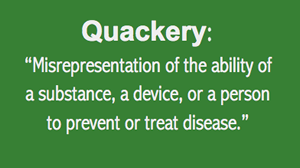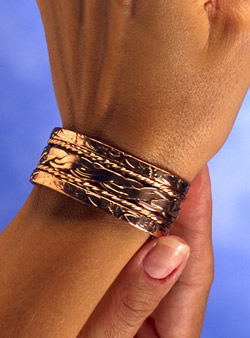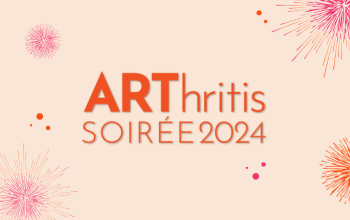Quackery and Arthritis
Written by: Gordon Whitehead
 It’s difficult to experience having one or more of the hundred plus arthritis diseases without encountering quack remedies. They literally litter the medical treatment landscape. If we don’t actually seek them out (though many of us do succumb to this impulse from time-to-time) then we trip across them in the form of fervently delivered health tips from concerned friends or relatives, or as material on the web; as books touting cures, as advertisements on TV and as Health store promotions.
It’s difficult to experience having one or more of the hundred plus arthritis diseases without encountering quack remedies. They literally litter the medical treatment landscape. If we don’t actually seek them out (though many of us do succumb to this impulse from time-to-time) then we trip across them in the form of fervently delivered health tips from concerned friends or relatives, or as material on the web; as books touting cures, as advertisements on TV and as Health store promotions.
This year, we Canadians will spend many millions of dollars on products and treatments that do nothing for us—or may do us injury. Why? Well, we do it for the same reasons that our ancestors have purchased quack cures since ancient times. As a species, we need to live in hope and we want to believe in miracles. And while we are better educated than our forebears and have witnessed the miraculous powers of modern scientific medicine, we are probably less inclined to be stoical about illness than they were and probably more prone to want, and indeed, to expect, immediate, pain free and simple, instant remedies.
The arthritis diseases represent a particularly fertile field for quack remedies for several reasons. First, while there are now effective treatments for many forms of arthritis, there are no “cures” for the various arthritis diseases. Second, the course of arthritis disease is often markedly uneven and many types of arthritis exhibit episodic “flares” followed by apparent “remissions”. This characteristic of arthritis allows persons to readily confuse cause and effect relationships (e.g. “I’m feeling better, so that copper bracelet must be working”).
During my first year after receiving a 1976 diagnosis for rheumatoid arthritis, I was told by well-meaning friends and acquaintances that I would be speedily rid of my disease if:
A) I drank apple cider vinegar;
B) became a vegetarian;
C) avoided all citrus fruits;
D) eliminated “nightshade” plants from my diet (potatoes, tomatoes, egg plant, peppers);
E) underwent bee sting therapy, and
F) eschewed all dairy products.
I was also told by others that it was best to refuse prescribed medications because they were all “terribly toxic” and that, in general, I should be deeply suspicious of “Big Pharma” because drug companies were only interested in getting me “hooked” on expensive medications and in suppressing awareness and knowledge of effective “alternative remedies”. I think my experience is fairly typical. Here is what another CAB colleague says about her own exploration of alternative treatments:
When I was diagnosed with rheumatoid arthritis in 1976, the disease spread to almost all my joints like a wild fire, fast and furious. I experienced excruciating pain and swelling all over my body, 24/7. The pain was present whether I was lying down, standing up, or sitting.
I was willing to try anything that promised to alleviate the pain. Well-intentioned family and friends who saw me suffer suggested numerous tips and remedies for me to try. A copper bracelet to wear on my painful wrist; it didn’t work. A magnetic pad for lower back pain; it didn’t work. Several different mixtures of roots and herbs; they didn’t work. A fermented tea, a cure-all drink; it didn’t work. Honey with vinegar; it didn’t work. Cod liver oil and devil’s claw; they didn’t work.
It was a very expensive process, but I felt that being pro-active with the disease was better than doing nothing and feeling helpless. I was desperate and impatient for anything that could help me get rid of the pain … I was practically crippled with the disease and enduring unbearable pain. I didn’t have a life!
In the end, what really helped me achieve remission was the combination of medications prescribed by my rheumatologist and the exercises recommended by my physiotherapist.
 Fortunately, in my own case, I didn’t abandon my physician-prescribed treatments in preference for any of these mentioned “remedies”, although I have experimented with some of them from time to time. I also used a number of “ancient” preparations (none of which did any good at all, as far as I could determine). And I did consult a Vancouver-based herbalist whose preparations were horribly smelly—and even a bit spooky but of no discernible positive impact on my disease.
Fortunately, in my own case, I didn’t abandon my physician-prescribed treatments in preference for any of these mentioned “remedies”, although I have experimented with some of them from time to time. I also used a number of “ancient” preparations (none of which did any good at all, as far as I could determine). And I did consult a Vancouver-based herbalist whose preparations were horribly smelly—and even a bit spooky but of no discernible positive impact on my disease.
But I have always had a high regard for empirical science and for the methodologies of science, and as I learned more about my own disease and the history of scientific medicine in general, my respect for science and for its careful and studied assessment of evidence has only deepened and expanded.
In the 1990’s a book claiming an “arthritis break-through” became a best-seller. I purchased it and read it carefully. After all, who could resist the pull of such a claim if they were combating arthritis? The book was written by an American rheumatologist who appeared to have highly respectable professional credentials and who also had extensive experience in treating patients with rheumatoid arthritis (RA). The book strongly implied that they had found both the cause of inflammatory arthritis and a cure for RA. The book appeared shortly after the discovery that peptic ulcers were caused by the helicobacter bacterium and it was then the fashion to look afresh for a bacterial origin for many other chronic diseases. The hypothesis presented in this book was that a bacterium triggered aberrant behaviour in the immune system, leading to the subsequent development of RA and other related diseases like lupus. It recommended a treatment regimen that employed long term, low dose ingestion of antibiotics and claimed to have had remarkable success with this approach. Although the author had not successfully identified the bacterium, which he alleged was responsible for initially triggering RA, he hypothesized its existence by the alleged success of antibiotics in treating the disease. I truly didn’t know what to make of these assertions, and so, for the first time, I made contact with the Arthritis Research Centre of Canada and asked for its assessment. I received a carefully written response, summarizing all the best information available on antibiotic therapy for rheumatoid arthritis. The conclusion appeared to be that ingestion of an antibiotic did have a mild anti-inflammatory impact but one that appeared to be not significantly greater than that produced by ingestion of a non-steroidal anti-inflammatory drug. I was extremely grateful for the balanced and thorough information I received on that occasion and from that point forward I resolved to become involved in the world of evidence-driven arthritis research—-hence my ongoing attachment to the Consumer Advisory Board (CAB) of the Arthritis Research Centre of Canada.
How does one recognize arthritis quackery?
Here are my own personal tests for recognizing quackery:
- There are some typical quack vocabulary words which appear regularly in titles, book blurbs, or ads. These may include: “Cure, Breakthrough, Secret, Guaranteed Relief, Special Treatment, and Exclusive”. These are not scientific words but promotional words that are aimed at selling you something.
- Be suspicious of anything or anyone promoting mistrust of established health institutions or disciplines. Your rheumatologist is a trained professional who really does know best.
- With the exception of gout, there is no credible evidence that any particular foods cause arthritis. A good, balanced, and nutritious diet is good for anyone with a chronic disease.
- When evaluating treatment claims, be leery of anecdotal testimonials that are not supported by credible research. You know the sort of thing I mean: “I was dancing like Fred Astaire two weeks after taking formulation X—- Fred Smirch, of Cedar Rapids, Iowa”. Have any of the claimed treatments been thoroughly assessed or have they undergone clinical trials? Have alleged therapeutic benefits been replicated in other controlled trials? Have results been published in reputable journals?
- Quality treatments are usually not accessible by mail order—and when it is alleged that “operators are standing by for your phone call”, keep them standing by.
- No one is keeping a secret cure for arthritis hidden from you and the public view. Arthritis is a hugely expensive and debilitating collection of diseases which every dedicated medical practitioner and every level of government would dearly love to extinguish—and if that could be done by simply ingesting a cheap extract of milkweed or devil’s claw, it would certainly be done.
- Watch for these telltale signs of a quack preparation: it retails for $30-$40 per month, and allegedly must be ingested for 6 months before signs of improvement are seen. Do the math. By the time you conclude that the preparation is useless and give it up, you’ve spent $180 or more. Imagine the profit margins for such a remedy, given that in Canada alone, more than 4,000,000 people now suffer from arthritis, with that number expected to grow rapidly in the not too distant future with the aging of the population.
Remember this: with the exception of a very few types of arthritis disease (Lyme disease, rheumatic fever, septic arthritis—and a very few others) most arthritis is not curable—yet. But arthritis can in many cases be put into remission or controlled if effective evidence-based treatments are followed. If you are tempted to experiment with “alternative treatments”, be sure to disclose these to your rheumatologist (some preparations are toxic; some alleged “natural remedies” have been found to contain cortisone) and above all, do not abandon your prescribed course of treatment in order to chase an unproven will-of the-wisp quack cure. Your joints will never forgive you!!






















































